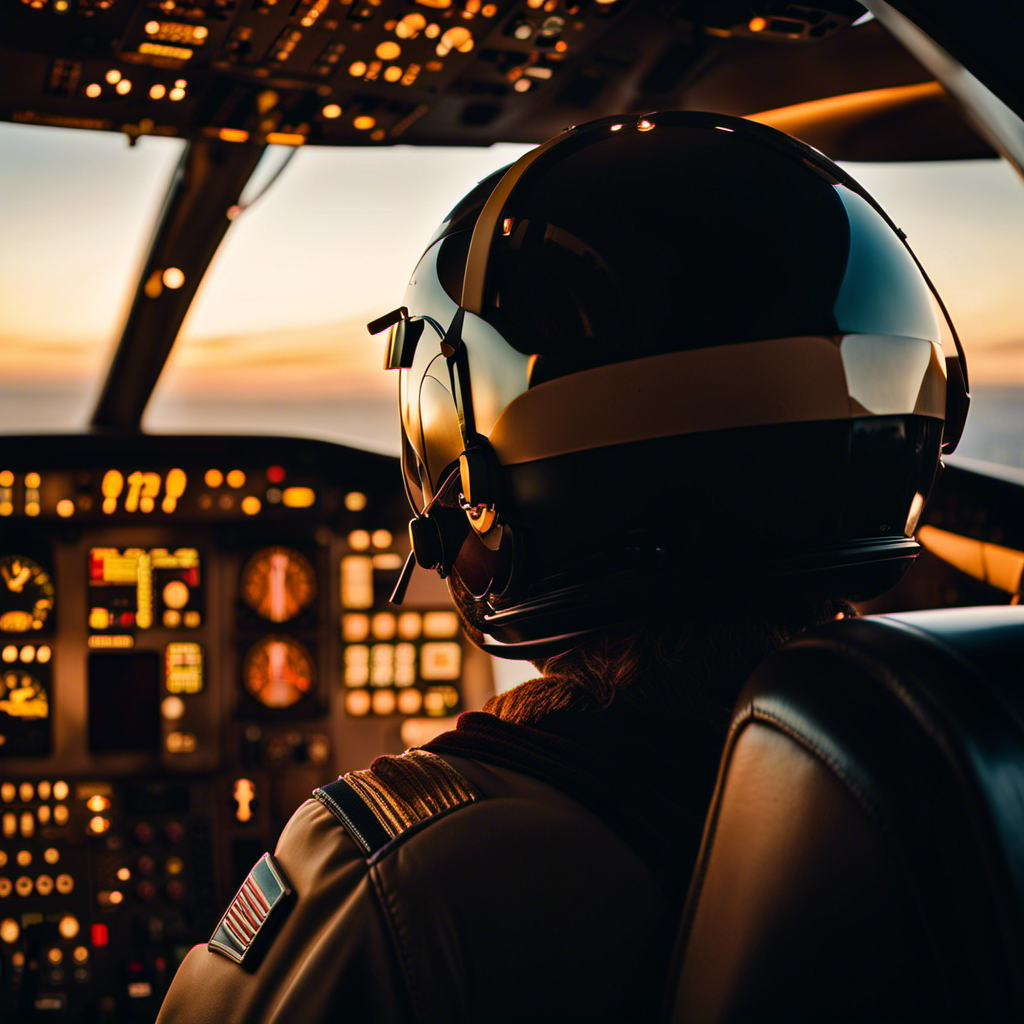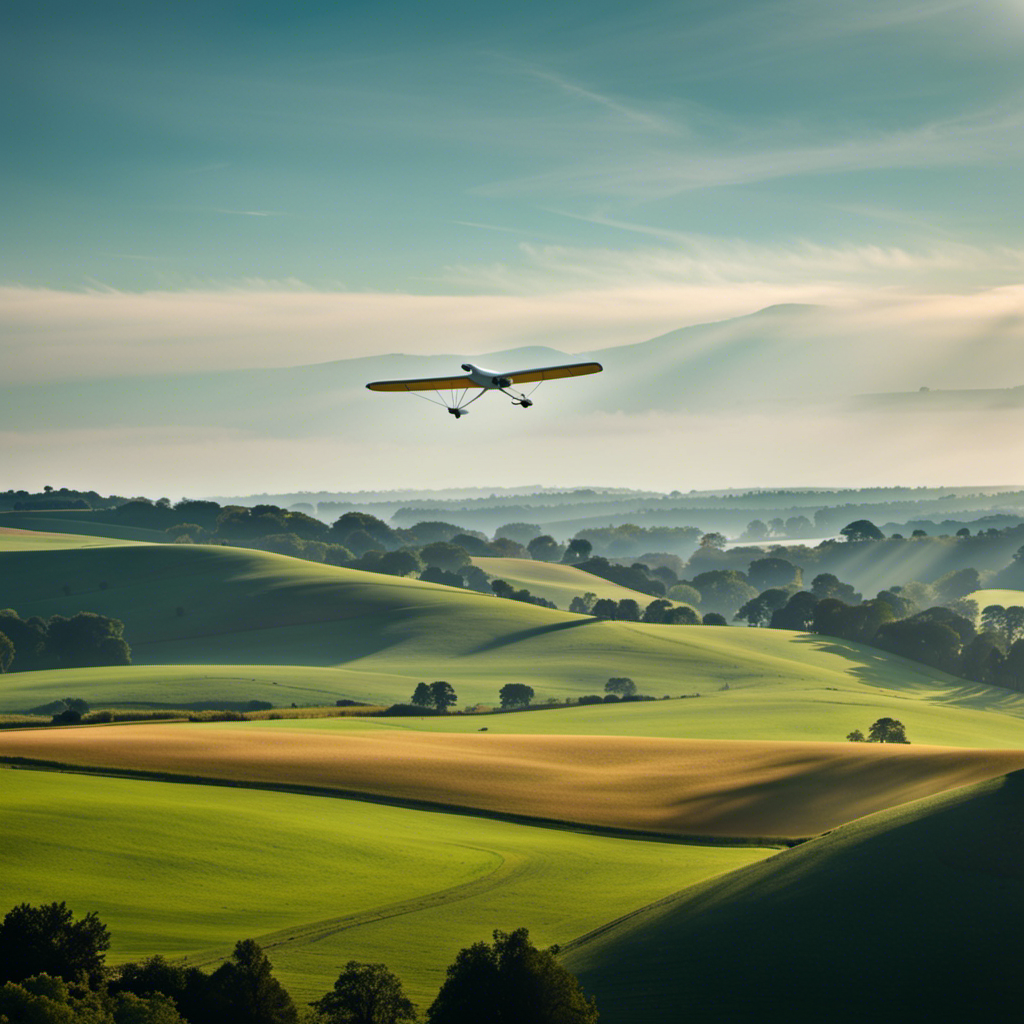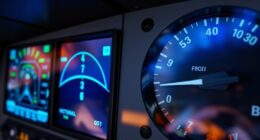Since I can recall, I have always dreamt of soaring through the skies, feeling the rush of adrenaline as I control an aircraft. I am excited to now offer this experience to you.
In this guide, we’ll dive into the world of aviation, exploring the basics, finding the right flight school, and obtaining the necessary licenses.
With a focus on technical precision, I’ll take you step-by-step through the process of learning how to pilot a plane.
So buckle up and get ready for an adventure like no other.
Key Takeaways
- Understanding key aviation terminology and principles of flight is crucial for learning how to pilot a plane.
- When choosing a flight school, consider factors such as location, reputation, and cost to find the best fit.
- Obtaining a student pilot license requires meeting certain requirements and completing medical exams and background checks.
- Enrolling in ground school is essential for mastering the fundamentals of flying and building a solid foundation.
Understanding the Basics of Aviation
Understanding the basics of aviation is essential for aspiring pilots. As a pilot, it’s crucial to be familiar with key aviation terminology and the basic principles of flight.
To begin, let’s delve into some of the key aviation terminology. Terms like airspeed, altitude, and heading are fundamental to flying. Airspeed refers to the speed of the aircraft in relation to the air around it, altitude is the height above sea level, and heading is the direction the aircraft is pointing.
Now, let’s move on to the basic principles of flight. These include lift, drag, thrust, and weight. Lift is generated by the wings, drag opposes the motion of the aircraft, thrust is the force propelling the aircraft forward, and weight is the force of gravity acting on the aircraft.
Understanding these concepts is the foundation for further exploration into the world of aviation.
Moving forward, let’s explore the next crucial step in becoming a pilot: choosing the right flight school.
Choosing the Right Flight School
When it comes to choosing the right flight school, you’ll want to consider factors such as location, reputation, and cost. Finding the perfect flight school is crucial to your aviation journey, and cost plays a significant role in your decision-making process.
Here are some cost considerations to keep in mind:
- Tuition fees: Compare the tuition fees of different flight schools to ensure you’re getting the best value for your money.
- Additional expenses: Take into account other expenses like textbooks, flight materials, and examination fees.
It’s important to strike a balance between cost and quality when selecting a flight school. While it may be tempting to choose the cheapest option, remember that the quality of education and training is equally important.
Now that you have chosen the right flight school, let’s explore the next step in your journey: getting your student pilot license.
Getting Your Student Pilot License
To get my student pilot license, I need to understand the requirements and eligibility criteria set by the aviation authority. This includes completing the necessary medical exams and background checks to ensure I’m physically fit and have no criminal record.
Once these steps are completed, I’ll need to enroll in ground school and pass the written exam. The exam will test my knowledge on topics like aerodynamics, navigation, and regulations.
Understand the requirements and eligibility criteria
Pilots must meet specific requirements and eligibility criteria in order to obtain their license. These requirements ensure that pilots possess the necessary skills and knowledge to safely operate an aircraft.
To begin with, individuals must be at least 17 years old to obtain a private pilot license and 16 years old to obtain a student pilot license. Additionally, aspiring pilots must have a minimum of 40 hours of flight time, including 20 hours of flight instruction and 10 hours of solo flight.
Moreover, pilots must pass a written exam and a practical test administered by the Federal Aviation Administration (FAA). These qualifications demonstrate a pilot’s proficiency in various areas such as aerodynamics, navigation, and emergency procedures.
Once these requirements are met, pilots can proceed to complete the necessary medical exams and background checks, ensuring their fitness to fly.
Complete the necessary medical exams and background checks
Make sure you’ve completed all the necessary medical exams and background checks before proceeding further in the licensing process.
Aspiring pilots must meet certain health and safety requirements to ensure their ability to perform in the demanding aviation industry. The necessary documentation includes a medical certificate issued by an approved aviation medical examiner. This comprehensive examination assesses physical and mental fitness, ensuring pilots are capable of handling the stresses of flying.
Additionally, background checks are conducted to verify an individual’s criminal history, ensuring the safety and security of passengers and crew. These checks are essential for maintaining the high standards of professionalism and responsibility expected in the aviation industry.
Once these exams and checks are successfully completed, you can then enroll in ground school and pass the written exam to progress further in your journey towards becoming a pilot.
Enroll in ground school and pass the written exam
Before enrolling in ground school and taking the written exam, it’s important to ensure that you have completed all the necessary medical exams and background checks. Understanding aviation regulations is crucial as you embark on your journey to become a pilot.
Once you have cleared these prerequisites, it’s time to find a flight instructor who can guide you through the next phase of your training. A knowledgeable flight instructor will not only teach you the required material but also provide valuable insights and hands-on experience.
Ground school will equip you with the theoretical knowledge needed to pass the written exam. This includes understanding aircraft systems, navigation procedures, meteorology, and more. Mastering the fundamentals of flying requires a solid foundation, and ground school is the first step in this exciting process.
Mastering the Fundamentals of Flying
As a student pilot, it’s crucial to master the fundamentals of flying. This includes learning how to perform pre-flight inspections, ensuring that the aircraft is in optimal condition before takeoff.
Additionally, practicing taxiing, takeoff, and landing techniques is essential for developing the necessary skills to safely control the aircraft during these critical phases of flight.
Furthermore, honing skills in navigation, communication, and maneuvering will ensure that you can confidently navigate through airspace, effectively communicate with air traffic control, and execute precise maneuvers while flying.
Learn how to perform pre-flight inspections
Performing pre-flight inspections is crucial for ensuring the safety of the aircraft. Before every flight, I meticulously go through a pre-flight checklist to ensure that all systems are functioning properly. Here are three important items that I always check:
-
Visual Inspection: I visually inspect the exterior of the aircraft, looking for any signs of damage or loose parts. This includes checking the wings, tail, landing gear, and propeller.
-
Fluid Levels: I check the fuel, oil, and hydraulic fluid levels to ensure that they are at the appropriate levels. This is essential for the proper functioning of the aircraft’s systems.
-
Control Surfaces: I check the control surfaces, such as the ailerons, elevator, and rudder, to make sure they are free of any obstructions and move smoothly.
By following this pre-flight checklist and conducting thorough inspections, I can ensure that the aircraft is in optimal condition for flight.
Now, let’s move on to practicing taxiing, takeoff, and landing techniques.
Practice taxiing, takeoff, and landing techniques
Now, let’s focus on practicing taxiing, takeoff, and landing techniques to improve your skills as a pilot. These fundamental skills are crucial for safe and efficient flight operations. It is essential to practice emergency procedures during these maneuvers to ensure you are prepared for any unexpected situations. Additionally, by practicing these techniques, you will also improve your communication skills with air traffic control, as clear and concise communication is vital for safe operations. Below is a table highlighting the key aspects to focus on during each phase of the flight:
| Phase | Technique | Importance |
|---|---|---|
| Taxiing | Smooth acceleration | Prevents nose wheel shimmy |
| Takeoff | Proper rotation | Ensures positive climb |
| Landing | Flare technique | Provides gentle touchdown |
Develop skills in navigation, communication, and maneuvering
After mastering the fundamental skills of taxiing, takeoff, and landing, it’s time to expand my aviation repertoire. Developing decision-making skills and improving situational awareness are crucial for a pilot’s success.
Navigation is a key aspect of this, as it involves understanding charts, plotting courses, and utilizing navigation aids. By honing my communication skills, I can effectively interact with air traffic control and other pilots, ensuring a safe and efficient flight.
Maneuvering is another skill to focus on, as it involves executing turns, climbs, descents, and maintaining precise control of the aircraft. These skills work in harmony to enhance my ability to make informed decisions and maintain awareness of my surroundings.
As I continue to build flight experience, these skills will serve as a solid foundation for my future endeavors in the cockpit.
Building Flight Experience
As a pilot, I’ve found that building flight experience is crucial for honing my skills and becoming a proficient aviator.
One way to do this is by logging flight hours with an instructor or flying solo. This allows for hands-on practice and guidance.
Additionally, exploring different types of flying, such as cross-country or aerobatics, can provide valuable exposure to diverse flight conditions and challenges.
Lastly, continuously refining my skills and knowledge through practice is essential for maintaining proficiency and staying up to date with the latest advancements in aviation.
Log flight hours with an instructor or solo
Before you can log flight hours with an instructor or solo, you need to obtain a student pilot certificate. This certification is essential as it ensures that you have met the necessary requirements and possess the knowledge and skills to safely operate an aircraft.
Once you have obtained your student pilot certificate, you can begin logging flight hours in a simulator. Simulators provide a realistic environment where you can practice various flight maneuvers and procedures. These hours count towards your total flight time and allow you to track your progress through flight logs.
As you gain proficiency, you can transition to logging flight hours with an instructor or flying solo. This progression allows you to further develop your skills and experience different aspects of flying, such as cross-country navigation or aerobatics.
Explore different types of flying, such as cross-country or aerobatics
Once you’ve gained proficiency in flying, you can start exploring different types of flying, like cross-country or aerobatics. These advanced flying techniques require a deeper understanding of the aircraft and precise control over its movements.
Here are three reasons why cross-country and aerobatics are exciting avenues to explore:
-
Cross-country flying allows you to navigate across vast distances, honing your navigation skills and experiencing the thrill of exploring new destinations.
-
Aerobatics, on the other hand, push the limits of your flying abilities, testing your coordination, precision, and control as you perform exhilarating maneuvers in the sky.
-
Both cross-country and aerobatics challenge your decision-making skills, as you encounter different weather conditions, airspace regulations, and performance limitations.
As you venture into these types of flying, continuously refining your skills and knowledge through practice becomes crucial.
Continuously refine your skills and knowledge through practice
Continuously refining skills and knowledge through practice is crucial when exploring different types of flying. As a pilot, it is essential to constantly improve and enhance your abilities.
One way to achieve this is by refining techniques using flight simulators. These advanced virtual environments allow pilots to simulate various flight scenarios and practice their skills in a safe and controlled setting.
By utilizing flight simulators, pilots can work on their maneuvering, decision-making, and emergency procedures. This hands-on experience helps build muscle memory and sharpens their ability to handle different flying situations.
As I prepare for the pilot practical test, I will continue to utilize flight simulators to fine-tune my skills and increase my confidence in the cockpit.
Preparing for the Pilot Practical Test
To prepare for the Pilot Practical Test, you’ll need to review all the necessary flight maneuvers and emergency procedures. This test is a crucial step towards obtaining your private pilot license, and it’s important to approach it with thorough preparation.
Here are some practical test tips to help you succeed:
- Familiarize yourself with the specific maneuvers and procedures required for the test, such as stalls, steep turns, and emergency landings.
- Practice these maneuvers extensively until you can perform them confidently and smoothly.
- Pay attention to the precise control inputs required for each maneuver.
- Be aware of the common mistakes that students tend to make, such as over-controlling or not maintaining proper airspeed.
Obtaining Your Private Pilot License
Remember, the process of obtaining your private pilot license requires dedication, practice, and a thorough understanding of flight maneuvers and emergency procedures.
To obtain flight experience and enhance your aviation skills, it is crucial to log the required number of flight hours. These hours serve as an opportunity to apply the knowledge gained during ground school and learn the practical aspects of flying.
Under the guidance of a certified flight instructor, you will practice takeoffs, landings, navigation, and emergency procedures. As you accumulate flight hours, your confidence and proficiency will grow, preparing you for the final step of passing the practical test.
It is important to approach each flight with a mindset of continuous improvement, always seeking to refine your skills and expand your knowledge base. By doing so, you will be well-prepared to continue your pilot education and pursue advanced certifications.
Continuing Your Pilot Education
As you progress in your pilot education, it’s essential to stay updated with the latest aviation regulations and industry trends. This will not only enhance your knowledge but also ensure you are flying safely and efficiently.
To continue your pilot education, there are several opportunities available:
- Enroll in advanced flight training courses to learn new techniques and hone your skills.
- Attend seminars and workshops conducted by industry experts to stay informed about the latest advancements in aviation.
- Take advantage of online resources and e-learning platforms that offer continuing education opportunities for pilots.
Joining Aviation Communities and Organizations
After completing my initial pilot education, I realized that there was still so much more to learn and experience in the world of aviation.
To further enhance my skills and knowledge, I decided to join aviation communities and organizations. Joining aviation clubs provided me with a network of like-minded individuals who shared the same passion for flying. These clubs offered various opportunities for me to engage in aviation-related activities, such as participating in fly-ins, attending seminars, and even volunteering at airshows.
Additionally, I actively sought out pilot mentors who could guide me through the intricacies of flying and provide valuable insights from their own experiences. Having a mentor not only helped me refine my skills but also allowed me to gain a deeper understanding of the aviation industry.
Embracing a Lifelong Passion for Flying
Joining aviation communities and organizations has allowed me to continuously fuel my lifelong passion for flying. Being part of these communities has not only connected me with like-minded individuals, but it has also provided me with valuable resources and opportunities to expand my knowledge and skills in aviation. Through these connections, I have been able to develop a flight plan that aligns with my goals and aspirations as a pilot. Additionally, being part of these communities has helped me overcome my fear of flying. Interacting with experienced pilots and hearing their stories of success and overcoming challenges has inspired and reassured me that I am capable of achieving my dreams in the world of aviation. Through continued engagement with these communities, I am confident in my ability to pursue a fulfilling career in aviation.
| Benefits of Joining Aviation Communities |
|---|
| Access to valuable resources and opportunities |
| Networking with like-minded individuals |
| Learning from experienced pilots |
| Overcoming fear of flying |
| Developing a flight plan that aligns with personal goals |
Frequently Asked Questions
How much does it cost to learn how to pilot a plane?
Learning to pilot a plane can be costly, with expenses ranging from $10,000 to $100,000. The total cost depends on factors such as training frequency, aircraft rental, instructor fees, and exam fees.
What are the physical requirements to become a pilot?
To become a pilot, physical limitations and medical requirements must be met. These include possessing good vision, hearing, and overall health. A comprehensive medical examination is necessary to ensure fitness for flying.
How often should I expect to fly during my flight training?
During flight training, the flight training schedule and intensity will vary depending on the program. Expect to fly several times a week, gradually increasing flight time and complexity as you progress.
Can I take breaks during my flight training if I have other commitments?
Yes, breaks can be taken during flight training to manage time commitments. It is important to schedule breaks in a way that allows for consistent progress and ensures that necessary training requirements are met.
Are there any age restrictions for obtaining a private pilot license?
There are age restrictions for obtaining a private pilot license. However, you can learn to pilot a plane at any age. It is important to meet the minimum age requirements set by the aviation authority in your country.
Conclusion
As I finish my journey in the cockpit, I can’t help but feel a mix of excitement and nostalgia. Learning how to pilot a plane has been an incredible experience, filled with challenges and triumphs.
The knowledge I have gained, the skills I have honed, and the connections I have made in the aviation community have all contributed to my growth as a pilot.
But this is not the end. It is only the beginning of a lifelong passion for flying. So, strap in, buckle up, and get ready to soar to new heights.
The sky is waiting.









